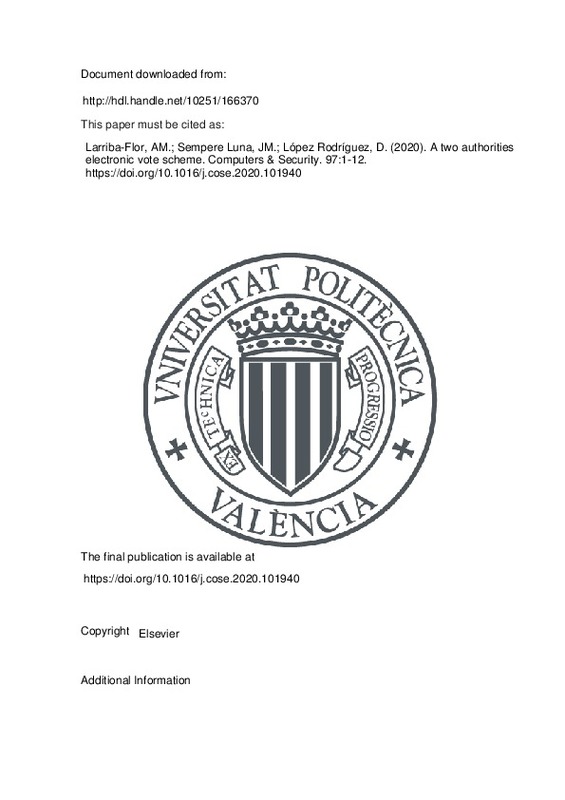JavaScript is disabled for your browser. Some features of this site may not work without it.
Buscar en RiuNet
Listar
Mi cuenta
Estadísticas
Ayuda RiuNet
Admin. UPV
A two authorities electronic vote scheme
Mostrar el registro sencillo del ítem
Ficheros en el ítem
| dc.contributor.author | Larriba-Flor, Antonio Manuel
|
es_ES |
| dc.contributor.author | Sempere Luna, José María
|
es_ES |
| dc.contributor.author | López Rodríguez, Damián
|
es_ES |
| dc.date.accessioned | 2021-05-14T12:41:09Z | |
| dc.date.available | 2021-05-14T12:41:09Z | |
| dc.date.issued | 2020-10 | es_ES |
| dc.identifier.issn | 0167-4048 | es_ES |
| dc.identifier.uri | http://hdl.handle.net/10251/166370 | |
| dc.description.abstract | [EN] In this paper we propose a new electronic multi-authority voting system based on blind signatures. We focus on the open problem of the efficiency of electronic voting systems. Most of the proposed systems rely on complex architectures or expensive proofs, in this work we aim to reduce the time-complexity of the voting process, both for the voter and the authorities involved. Our system is focused on simplicity and it is based on the assumption of two unrelated entities. This simplicity makes our approach scalable and flexible to multiple kinds of elections. We propose a method that limits the number of authorities to only 2 of them; we reduce the overall number of modular operations; and, propose a method which cut downs the interactions needed to cast a vote. The result is a voting protocol whose complexity scales linearly with the number of votes. | es_ES |
| dc.language | Inglés | es_ES |
| dc.publisher | Elsevier | es_ES |
| dc.relation.ispartof | Computers & Security | es_ES |
| dc.rights | Reconocimiento - No comercial - Sin obra derivada (by-nc-nd) | es_ES |
| dc.subject | Electronic vote | es_ES |
| dc.subject | Homomorphic cryptography | es_ES |
| dc.subject | Multi-authority system | es_ES |
| dc.subject | Blind signatures | es_ES |
| dc.subject | RSA | es_ES |
| dc.subject.classification | LENGUAJES Y SISTEMAS INFORMATICOS | es_ES |
| dc.title | A two authorities electronic vote scheme | es_ES |
| dc.type | Artículo | es_ES |
| dc.identifier.doi | 10.1016/j.cose.2020.101940 | es_ES |
| dc.rights.accessRights | Abierto | es_ES |
| dc.contributor.affiliation | Universitat Politècnica de València. Departamento de Sistemas Informáticos y Computación - Departament de Sistemes Informàtics i Computació | es_ES |
| dc.description.bibliographicCitation | Larriba-Flor, AM.; Sempere Luna, JM.; López Rodríguez, D. (2020). A two authorities electronic vote scheme. Computers & Security. 97:1-12. https://doi.org/10.1016/j.cose.2020.101940 | es_ES |
| dc.description.accrualMethod | S | es_ES |
| dc.relation.publisherversion | https://doi.org/10.1016/j.cose.2020.101940 | es_ES |
| dc.description.upvformatpinicio | 1 | es_ES |
| dc.description.upvformatpfin | 12 | es_ES |
| dc.type.version | info:eu-repo/semantics/publishedVersion | es_ES |
| dc.description.volume | 97 | es_ES |
| dc.relation.pasarela | S\415840 | es_ES |
| dc.description.references | Bloom, B. H. (1970). Space/time trade-offs in hash coding with allowable errors. Communications of the ACM, 13(7), 422-426. doi:10.1145/362686.362692 | es_ES |
| dc.description.references | Brams S., Fishburn P.C.. 2007. Approval voting Springer Science | es_ES |
| dc.description.references | Carroll, T. E., & Grosu, D. (2009). A secure and anonymous voter-controlled election scheme. Journal of Network and Computer Applications, 32(3), 599-606. doi:10.1016/j.jnca.2008.07.010 | es_ES |
| dc.description.references | Chaum, D. L. (1981). Untraceable electronic mail, return addresses, and digital pseudonyms. Communications of the ACM, 24(2), 84-90. doi:10.1145/358549.358563 | es_ES |
| dc.description.references | Cramer, R., Gennaro, R., & Schoenmakers, B. (1997). A secure and optimally efficient multi-authority election scheme. European Transactions on Telecommunications, 8(5), 481-490. doi:10.1002/ett.4460080506 | es_ES |
| dc.description.references | Desmedt, Y. G. (2010). Threshold cryptography. European Transactions on Telecommunications, 5(4), 449-458. doi:10.1002/ett.4460050407 | es_ES |
| dc.description.references | Elgamal, T. (1985). A public key cryptosystem and a signature scheme based on discrete logarithms. IEEE Transactions on Information Theory, 31(4), 469-472. doi:10.1109/tit.1985.1057074 | es_ES |
| dc.description.references | Juang, W.-S. (2002). A Verifiable Multi-Authority Secret Election Allowing Abstention from Voting. The Computer Journal, 45(6), 672-682. doi:10.1093/comjnl/45.6.672 | es_ES |
| dc.description.references | Menezes A., van Oorschot P.C., Vanstone S.A.. 1996. Handbook of Applied Cryptography. | es_ES |
| dc.description.references | Parhami, B. (1994). Voting algorithms. IEEE Transactions on Reliability, 43(4), 617-629. doi:10.1109/24.370218 | es_ES |
| dc.description.references | Rabin, M. O. (1980). Probabilistic Algorithms in Finite Fields. SIAM Journal on Computing, 9(2), 273-280. doi:10.1137/0209024 | es_ES |
| dc.description.references | Rabin, M. O. (1983). Transaction protection by beacons. Journal of Computer and System Sciences, 27(2), 256-267. doi:10.1016/0022-0000(83)90042-9 | es_ES |
| dc.description.references | Salazar, J. L., Piles, J. J., Ruiz-Mas, J., & Moreno-Jiménez, J. M. (2010). Security approaches in e-cognocracy. Computer Standards & Interfaces, 32(5-6), 256-265. doi:10.1016/j.csi.2010.01.004 | es_ES |
| dc.description.references | Nguyen, T. A. T., & Dang, T. K. (2013). Enhanced security in internet voting protocol using blind signature and dynamic ballots. Electronic Commerce Research, 13(3), 257-272. doi:10.1007/s10660-013-9120-5 | es_ES |
| dc.description.references | Wu, Z.-Y., Wu, J.-C., Lin, S.-C., & Wang, C. (2014). An electronic voting mechanism for fighting bribery and coercion. Journal of Network and Computer Applications, 40, 139-150. doi:10.1016/j.jnca.2013.09.011 | es_ES |
| dc.description.references | Yang, X., Yi, X., Nepal, S., Kelarev, A., & Han, F. (2018). A Secure Verifiable Ranked Choice Online Voting System Based on Homomorphic Encryption. IEEE Access, 6, 20506-20519. doi:10.1109/access.2018.2817518 | es_ES |
| dc.description.references | Yi, X., & Okamoto, E. (2013). Practical Internet voting system. Journal of Network and Computer Applications, 36(1), 378-387. doi:10.1016/j.jnca.2012.05.005 | es_ES |







![[Cerrado]](/themes/UPV/images/candado.png)

